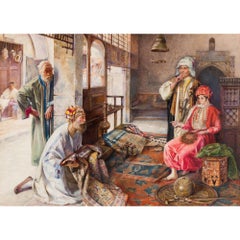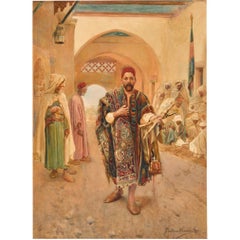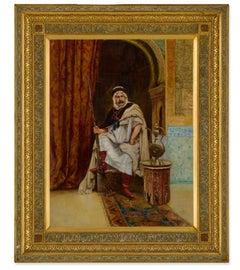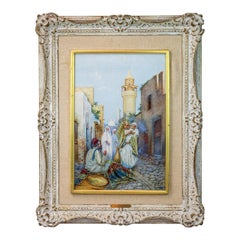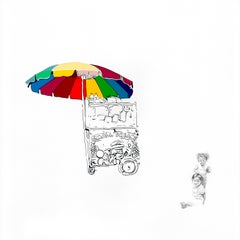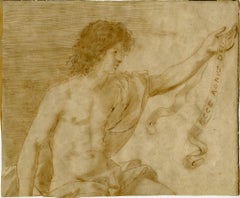F & P Associates Drawings and Watercolor Paintings
to
3
1
Overall Width
to
Overall Height
to
3
1
4
4
4
3
2
4
3
2
1
1
1
4
4
Tito Della Fralte Orientalist Watercolor The silk Rug .
Located in New York, NY
Title: Rug Merchant
Artist: Tito Della Fralte (20th C.)
Origin: French
Medium: Watercolor and pencil on paper
Dimension: 19 x 26 inches
Signed Tito Della Fralte and inscribed Roma (lr)
Category
Early 20th Century Portrait Drawings and Watercolors
Materials
Watercolor, Pencil
Gustavo Simoni Merchant Abundant Orientalist Watercolor
Located in New York, NY
Merchant Abundant
A merchant walks through a covered marketplace draped in rugs and holding intricately decorated knives.
Signed lower right : Gustavo Simoni
Medium: Watercolor ...
Category
19th Century Portrait Drawings and Watercolors
Materials
Watercolor, Pencil
Clemente Pujol de Gustavino An orientalist Arab Guardsman
Located in New York, NY
Artist: Clemente Pujol de Guastavino (1850-1905)
Origin: Spanish
Signature: signed C. Pujol (lower right)
Medium: oil on canvas
Dimension: 25 1/2 in x 19 3/4 in. Framed 34 by 2...
Category
19th Century Portrait Drawings and Watercolors
Materials
Canvas, Oil
Orientalist Watercolor Painting a Carpet Merchant by Eugene Louis Lami
By Eugène Louis Lami
Located in New York, NY
The Carpet Seller depicts a man in a domed Fez hat as he is approached by three women and a child. Middle eastern architecture floods the scene. The way the pa...
Category
19th Century Figurative Drawings and Watercolors
Materials
Watercolor
Related Items
"Sueńos Chicos" (FRAMED) Painting 21" x 20.5" inch by Antonio Pelayo
By Antonio Pelayo
Located in Culver City, CA
"Sueńos Chicos" (FRAMED) Painting 21" x 20.5" inch by Antonio Pelayo
Medium: Pencil on Paper. Acrylic Ink & Paint on Animation Acetate
Image size: 15...
Category
21st Century and Contemporary Contemporary Figurative Drawings and Water...
Materials
Ink, Acrylic
$3,000
H 21 in W 20.5 in D 1 in
St. John the Baptist in the wilderness , Ecce Agnus Dei (Behold the Lamb of God)
By Giovanni Francesco Barbieri (Il Guercino)
Located in Middletown, NY
Pen and sepia ink and wash on vellum, 8 7/8 x 10 1/2 inches (225 x 267 mm). In very good condition with some modern notations in pencil on the verso, minor cockling, and a 1-inch hor...
Category
Mid-17th Century Old Masters Portrait Drawings and Watercolors
Materials
Ink, Watercolor, Vellum, Pencil
$650
H 8.88 in W 10.5 in
Neoclassical composition of a sculptor kneeling before his statue of the Madonna
Located in Middletown, NY
An allegory of loyalty, with the subject's dog pictured seated, holding his master's chisel in his mouth; fidelity personified.
Italian School, 18th century
Ink wash in gray and bl...
Category
Mid-18th Century Italian School Figurative Paintings
Materials
Laid Paper, Ink, Watercolor
$500
H 9.73 in W 7.01 in
"Almond blossom" ( almond trees blossom inspired by Vincent va Gogh)
Located in VÉNISSIEUX, FR
This painting features almond trees which are coming into full flower: big branches of white and light pink almond blossom against a blue sky. In these flowering trees, I wanted to ...
Category
2010s Contemporary Still-life Paintings
Materials
Acrylic, Paper
$173 Sale Price
79% Off
H 16.54 in W 11.7 in D 0.04 in
"Vase with gladioli in August " (contemporary floral piece inspired by Van Gogh)
Located in VÉNISSIEUX, FR
This still-life painting depicts a bouquet of yellow, red and dark pink gladioli in a vase on the wooden table.
This painting allow me to discover a wider palette, exploring new co...
Category
2010s Contemporary Still-life Paintings
Materials
Acrylic, Paper
$339 Sale Price
60% Off
H 16.54 in W 11.7 in D 0.04 in
Mayan, Large 20th Century Watercolor, Cleveland School, Viktor Schreckengost
By Viktor Schreckengost
Located in Beachwood, OH
Viktor Schreckengost (American, 1906-2008)
Mayan
Watercolor heightened with gouache over pencil on paper
Signed lower right
39 x 29 inches
45.5 x 35.5 inches, framed
Registered with The Viktor Schreckengost foundation, stock no. 6891
The son of a commercial potter in Sebring, Ohio, Viktor Schreckengost learned the craft of sculpting in clay from his father. In the mid-1920s, he enrolled at the Cleveland School of Art (now the Cleveland Institute of Art, or CIA) to study cartoon making, but after seeing an exhibition at the Cleveland Museum of Art he changed his focus to ceramics. Upon graduation in 1929, he studied ceramics in Vienna, Austria, where he began to build a reputation, not only for his art, but also as a jazz saxophonist. A year later, at the age of 25, he became the youngest faculty member at the CIA. In 1931, Schreckengost won the first of several awards for excellence in ceramics at the Cleveland Museum of Art, and his works were shown at the Metropolitan Museum of Art, the Art Institute of Chicago, the Panama-Pacific Exposition in San Francisco, and elsewhere.
By the mid-1930s, Schreckengost had begun to pursue his interest in industrial design. For American Limoges...
Category
20th Century American Modern Figurative Drawings and Watercolors
Materials
Watercolor, Gouache
$6,500
H 45.5 in W 35.5 in
Self Portrait 02 - Modern Figurative Watercolor Painting, New Expressionism
By Maciej Olekszy
Located in Salzburg, AT
The artwork on paper will be sent unframed to you.
Maciej Olekszy was born in 1982, Poland. Graduated from the Academy of Fine Arts in Poznan, Poland in 2007. Faculty of Painting i...
Category
2010s Contemporary Figurative Paintings
Materials
Paper, Watercolor
$1,418
H 41.34 in W 29.53 in
Rare Modernist Hungarian Rabbi Pastel Drawing Gouache Painting Judaica Art Deco
By Hugó Scheiber
Located in Surfside, FL
Rabbi in the synagogue at prayer wearing tallit and tefillin.
Hugó Scheiber (born 29 September 1873 in Budapest – died there 7 March 1950) was a Hungarian modernist painter.
Hugo Scheiber was brought from Budapest to Vienna at the age of eight where his father worked as a sign painter for the Prater Theater. At fifteen, he returned with his family to Budapest and began working during the day to help support them and attending painting classes at the School of Design in the evening, where Henrik Papp was one of his teachers. He completed his studies in 1900. His work was at first in a post-Impressionistic style but from 1910 onward showed his increasing interest in German Expressionism and Futurism. This made it of little interest to the conservative Hungarian art establishment.
However, in 1915 he met the great Italian avant-gardist Filippo Tommaso Marinetti and the two painters became close friends. Marinetti invited him to join the Futurist Movement. The uniquely modernist style that he developed was, however, closer to German Expressionism than to Futurism and eventually drifted toward an international art deco manner similar to Erté's. In 1919, he and his friend Béla Kádar held an exhibition at the Hevesy Salon in Vienna. It was a great success and at last caused the Budapest Art Museum to acquire some of Scheiber's drawings. Encouraged, Scheiber came back to live in Vienna in 1920.
A turning point in Scheiber's career came a year later, when Herwarth Walden, founder of Germany's leading avant-garde periodical, Der Sturm, and of the Sturm Gallery in Berlin, became interested in Scheiber's work. Scheiber moved to Berlin in 1922, and his paintings soon appeared regularly in Walden's magazine and elsewhere. Exhibitions of his work followed in London, Rome, La Paz, and New York.
Scheiber's move to Germany coincided with a significant exodus of Hungarian artists to Berlin, including Laszlo Moholy-Nagy and Sandor Bortnyik. There had been a major split in ideology among the Hungarian avant-garde. The Constructivist and leader of the Hungarian avantgarde, Lajos Kassák (painted by Hugó Scheiber in 1930) believed that art should relate to all the needs of contemporary humankind. Thus he refused to compromise the purity of his style to reflect the demands of either the ruling class or socialists and communists. The other camp believed that an artist should be a figurehead for social and political change.
The fall out and factions that resulted from this politicisation resulted in most of the Hungarian avant gardists leaving Vienna for Berlin. Hungarian émigrés made up one of the largest minority groups in the German capital and the influx of their painters had a significant effect on Hungarian and international art. Another turning point of Scheiber's career came in 1926, with the New York exhibition of the Société Anonyme, organized by Katherine Dreier. Scheiber and other important avant garde artists from more than twenty-three countries were represented. In 1933, Scheiber was invited by Marinetti to participate in the great meeting of the Futurists held in Rome in late April 1933, Mostra Nazionale d’Arte Futurista where he was received with great enthusiasm. Gradually, the Hungarian artists began to return home, particularly with the rise of Nazism in Germany. Kádar went back from Berlin in about 1932 and Scheiber followed in 1934.
He was then at the peak of his powers and had a special flair in depicting café and cabaret life in vivid colors, sturdily abstracted forms and spontaneous brush strokes. Scheiber depicted cosmopolitan modern life using stylized shapes and expressive colors. His preferred subjects were cabaret and street scenes, jazz musicians, flappers, and a series of self-portraits (usually with a cigar). his principal media being gouache and oil. He was a member of the prestigious New Society of Artists (KUT—Képzőművészek Új Társasága)and seems to have weathered Hungary's post–World War II transition to state-communism without difficulty. He continued to be well regarded, eventually even receiving the posthumous honor of having one of his images used for a Russian Soviet postage stamp (see image above). Hugó Scheiber died in Budapest in 1950.
Paintings by Hugó Scheiber form part of permanent museum collections in Budapest (Hungarian National Museum), Pecs (Jannus Pannonius Museum), Vienna, New York, Bern and elsewhere. His work has also been shown in many important exhibitions, including:
"The Nell Walden Collection," Kunsthaus Zürich (1945)
"Collection of the Société Anonyme," Yale University Art Gallery, New Haven, Connecticut (1950)
"Hugó Scheiber: A Commemorative Exhibition," Hungarian National Museum, Budapest (1964)
"Ungarische Avantgarde," Galleria del Levante, Munich (1971)
"Paris-Berlin 1900-1930," Centre Georges Pompidou, Paris (1978)
"L’Art en Hongrie, 1905-1920," Musée d’Art et l’Industrie, Saint-Etienne (1980)
"Ungarische Avantgarde in der Weimarer Republik," Marburg (1986)
"Modernizmus," Eresz & Maklary Gallery, Budapest (2006)
"Hugó Scheiber & Béla Kádár," Galerie le Minotaure, Paris and Tel Aviv (2007)
Hugó Scheiber's paintings continue to be regularly sold at Sotheby's, Christie's, Gillen's Arts (London), Papillon Gallery (Los Angeles) and other auction houses.
He was included in the exhibition The Art Of Modern Hungary 1931 and other exhibitions along with Vilmos Novak Aba, Count Julius Batthyany, Pal Bor, Bela Buky, Denes Csanky, Istvan Csok, Bela Czobel, Peter Di Gabor, Bela Ivanyi Grunwald, Baron Ferenc Hatvany, Lipot Herman, Odon Marffy, C. Pal Molnar...
Category
Early 20th Century Modern Figurative Paintings
Materials
Paper, Charcoal, Pastel, Watercolor, Gouache
$5,500
H 15.75 in W 14.5 in
Jean Michel Basquiat Portrait. From the Series Maestros
Located in Miami Beach, FL
From the Series Maestro Jean Michel Basquiat, 2017
Watercolor, pencil on paper
Size: 50 H x 45 W cm
framed size 70 H x 62 W x 4 D cm
Unique
Wood frame
______
Emerson Cáceres, artis...
Category
2010s Contemporary Figurative Drawings and Watercolors
Materials
Watercolor, Archival Paper, Pencil
$2,000
H 19.69 in W 17.72 in D 0.12 in
Finding Space II, soft pastel on paper, still life, neutral and green flowers
By Angela A'Court
Located in New York, NY
Couple / Pair / Lovers / Love / Wedding / Romance / Flowers / Bouquet / Still life
Angela A’Court’s narrative and still life drawings use a simple and direct vocabulary to show the ...
Category
2010s Contemporary Figurative Drawings and Watercolors
Materials
Paper, Pastel
$3,400
H 19.5 in W 25.5 in
Gibson Girls - Set of Two 1920's Portraits, Vintage Fashion Illustrations
Located in Soquel, CA
Gorgeous pair of two 1920's watercolor portraits of Gibson girls, one in blue and one in pink, by Charles Hollman (Dutch, 1877-1953). Each portrait renders...
Category
1920s American Impressionist Portrait Drawings and Watercolors
Materials
Paper, Watercolor
$920 Sale Price
20% Off
H 13 in W 11 in D 2 in
Fool's Paradise Movie Costume Sketch Cecil B. DeMille - Classic Hollywood
Located in Miami, FL
Natacha Rambova imaginatively conceives and sketches a costume for Cecil B. DeMille's 1921 movie Fool's Paradise: Paramount. Rendered in Gouache, watercolor, pencil, and metallic s...
Category
1920s Symbolist Figurative Drawings and Watercolors
Materials
Silver, Bronze
$12,000
H 13.5 in W 9.75 in
